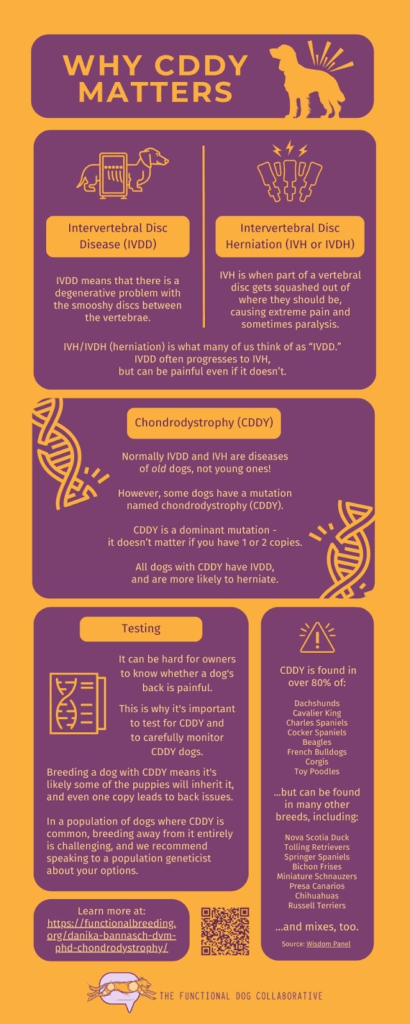Functional Thoughts
The FDC’s Stance on Chondrodystrophy (CDDY)
The Functional Dog Collaborative is grateful to Dr. Danika Bannasch for her insights on chondrodystrophy (CDDY) on the Functional Breeding Podcast.
The FDC’s stance on CDDY is summarized here.
- The phenotype associated with CDDY is somewhat subtle – CDDY is not required for short legs. However, the CDDY phenotype is preferred in some populations, and has been selected for.
- All dogs with 1 or 2 copies of CDDY have premature degeneration of their discs (“intervertebral disc disease type 1”, or IVDD).
- IVDD increases the risk for disc herniation (IVH or IVDH), which can cause severe pain and neurological symptoms up to paralysis (“catastrophic herniation,” and what most of us have previously labeled “IVDD”).
- Herniations without overt clinical signs can happen and go unnoticed (“non-catastrophic herniation”). Herniations can cause discomfort or pain that may be difficult to detect.
- Whether IVDD causes pain without herniation is currently unclear and controversial – it seems that some discs may be painful, but not in all dogs. The risk of this occurring is unknown. If you are concerned about pain in your CDDY dog, you should seek a professional to evaluate the dog. These professionals include sports medicine and/or rehabilitation veterinarians.
- Risk of herniation in CDDY dogs varies among breeds and is influenced by environmental factors.
- Therefore, risk of herniation has some genetic influence separate from CDDY, which presumably can be selected for, and this is being attempted in some breeds/countries.
- However, CDDY remains the main risk for herniation. Removing it from a population will have by far the largest effect in reducing that risk, particularly in young dogs.
- How easy it will be to breed away from CDDY depends on the CDDY allele frequency in the population.
- Genetic diversity should be considered when selecting away from CDDY to avoid genetic bottlenecks. In some populations, it will not be possible to remove CDDY without repeated outcrossing.
The Functional Dog Collaborative does not condone any sort of hostility towards people who own or breed CDDY dogs. Remember, also, you cannot know a dog’s CDDY status by visual inspection.
For more information:
Read the episode transcript for the Functional Breeding Podcast featuring Danika Bannasch here.

